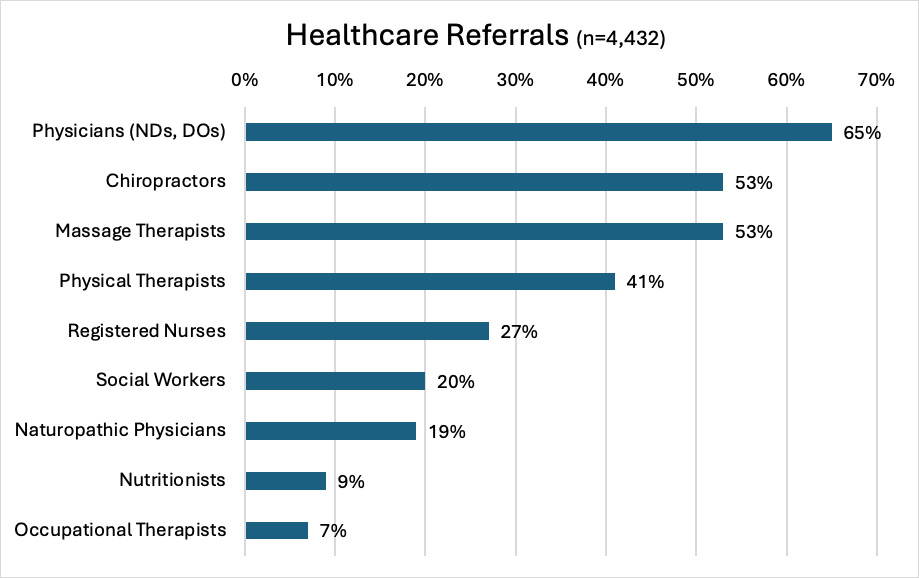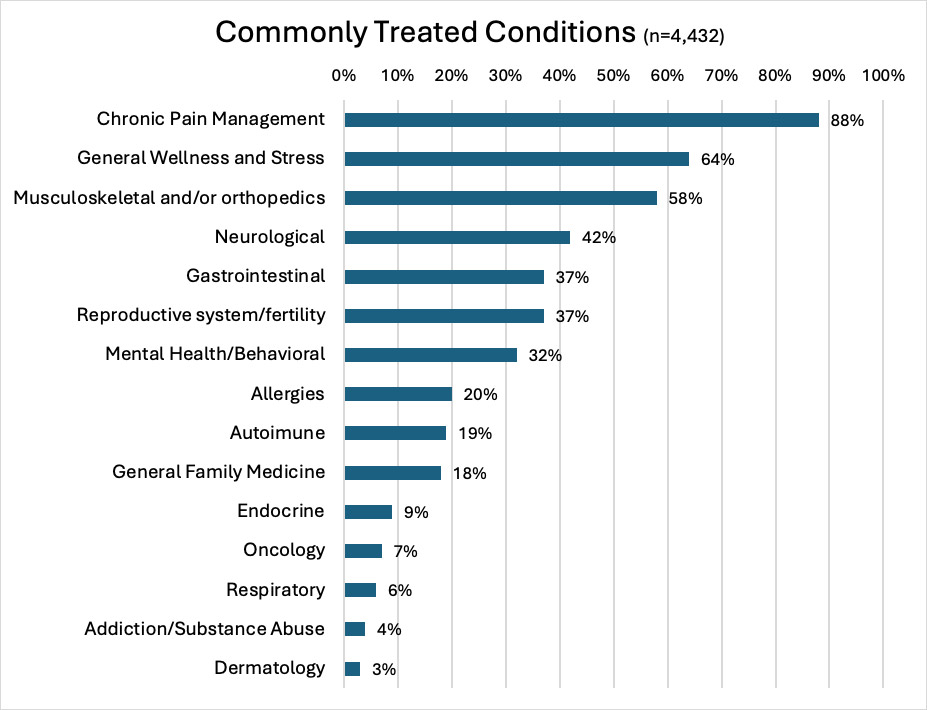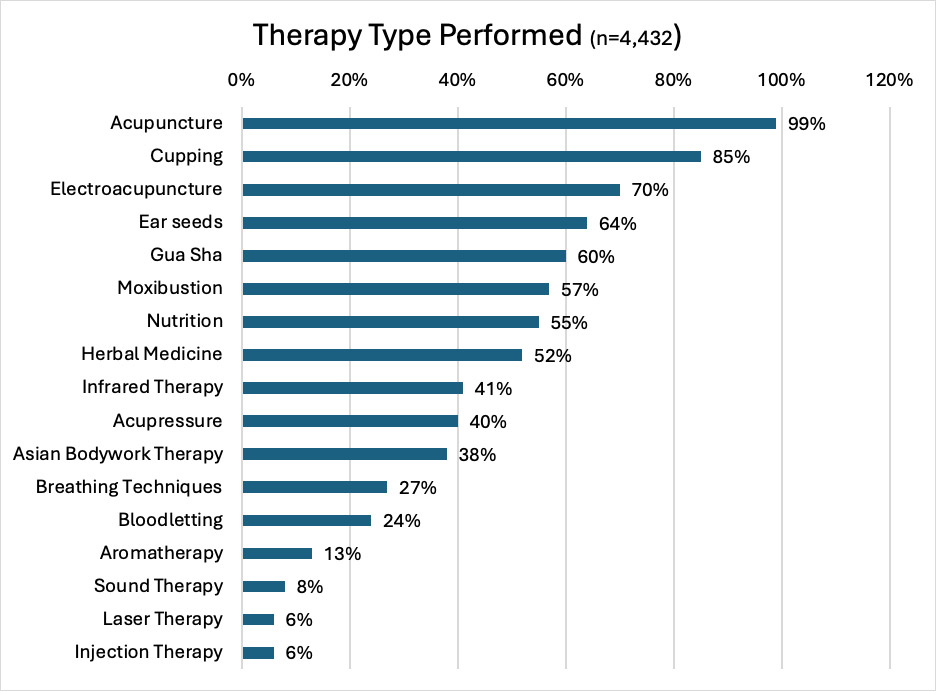Whether you accept it, avoid it or live somewhere in between, insurance coverage has become a defining issue for our profession. Patients increasingly expect to use their benefits, practitioners want to be compensated fairly for their time and expertise, and the system itself remains – at best – fragmented. The encouraging news is that coverage has expanded in meaningful ways. The challenging news is that reimbursement, across the board, remains inadequate.
NCCAOM 2024 Job Analysis: Key Findings and Insights
Referrals From Other Healthcare Practitioners
Sixty-five percent (65%) of respondents receive patient referrals from physicians or doctors of osteopathic medicine, 53% from chiropractors, and 53% from massage therapists. Forty-one percent of respondents receive patient referrals from physiotherapists.
(Note: The sum of percentages exceeds 100% because respondents could select more than one response category.)
This distribution provides a clear picture of the referral patterns to acupuncture practitioners, emphasizing the prominence of physicians, chiropractors and massage therapists in recognizing the value of acupuncture in patient care.

Most Commonly Treated Conditions
Acupuncturists treat a broad spectrum of conditions. Breaking it down by category of chief concern they most often address in practice, 88% of respondents see patients with chronic pain, and 64% see patients who want to increase their well-being and reduce stress levels. Fifty-eight percent (58%) of respondents see patients for musculoskeletal and orthopedic problems and 42% for neurological problems, such as headache.
Note: The sum of percentages exceeds 100% because respondents could select more than one response category.
These conditions represent just a few examples of the broad spectrum of ailments that acupuncturists can effectively treat. The holistic nature of acupuncture allows it to address both physical and emotional aspects of health, providing comprehensive care for a wide range of conditions.
The variety of conditions treated by acupuncture practitioners underscores the flexibility and effectiveness of acupuncture in promoting health and well-being across different aspects of patient care. This diversity in treatment options enhances the overall value of acupuncture as a complementary and integrative health care practice.

Most Frequently Used Acupuncture Techniques / Treatment Modalities
Approximately all survey respondents (99%) perform acupuncture, and 85% perform cupping. Seventy (70%) percent of respondents provide electroacupuncture services, 64 % perform ear seed treatments, 60% perform gua sha, and 57% perform moxibustion.
Note: The sum of percentages exceeds 100% because respondents could select more than one response category.
- Acupuncturists employ a wide range of treatment modalities to address various health concerns, with acupuncture (99%) being the most widely used method. This overwhelming majority highlights acupuncture as the foundation of practice, ensuring its role as the primary intervention for patient care.
- Ear seeds, cupping, electroacupuncture, gua sha, and moxibustion are widely used, emphasizing hands-on and heat-based therapies.
- Nutrition (55%) and herbal medicine (52%) play a strong role in holistic patient care.
- Emerging therapies like laser and injection therapy are used by a small, but growing number of practitioners (6% apiece), indicating evolving treatment approaches.
- This distribution of treatment methods highlights the versatility of acupuncture practitioners in addressing a wide range of patient needs, from pain management to overall wellness.

Key Clinical Trends
The treatment planning process is a fundamental aspect of patient care in acupuncture and herbal medicine. It involves creating a structured plan that outlines the course of treatment, goals and expected outcomes. This process ensures that patients receive personalized and effective care tailored to their specific needs.
Interdisciplinary Collaboration: The majority of practitioners reported working with other health care professionals. This interdisciplinary collaboration is crucial for providing comprehensive care to patients.
By collaborating with medical doctors, physical therapists, nutritionists, and other specialists, acupuncturists can ensure that their patients receive a holistic approach to treatment. This collaboration allows for the integration of different perspectives and expertise, leading to more effective and well-rounded care plans.
Diversity of Conditions Treated: The survey revealed that all practitioners report treating a broader range of patient conditions. This diversity indicates that acupuncture and herbal medicine are being utilized to address a wide variety of health issues, from chronic pain and musculoskeletal disorders to mental health and digestive problems.
The ability to treat such a diverse range of conditions highlights the versatility and effectiveness of these practices. It also underscores the importance of a thorough treatment planning process to ensure that each patient’s unique needs are met.
Use of Non-Needle Therapies: Large number of practitioners integrate complementary techniques, such as non-needle therapies, into their treatment plans. These therapies include cupping, gua sha, tui na, and herbal medicine. The integration of these techniques allows practitioners to provide a more comprehensive and multifaceted approach to patient care.
Non-needle therapies can enhance the effectiveness of acupuncture treatments, address specific symptoms and promote overall well-being. By incorporating these complementary techniques, practitioners can offer a broader range of treatment options and tailor their care to the individual needs of each patient.
The Bigger Picture
The 2024 NCCAOM Job Analysis report offers a wealth of insights into the current state and future direction of acupuncture and herbal medicine practice. By examining the demographic and clinical trends, the report underscores the dynamic and evolving nature of the profession. These findings are instrumental in shaping the future of certification standards, ensuring that practitioners are equipped with the knowledge and skills necessary to meet the demands of modern health care.
The report’s emphasis on interdisciplinary collaboration, diversity of conditions treated, and the integration of complementary techniques highlights the holistic approach that is central to acupuncture and herbal medicine. This approach not only enhances patient care, but also fosters a more inclusive and comprehensive health care system.
As the field continues to grow and adapt, the insights from this report will guide the NCCAOM in providing demographic information and trends to government agencies. In August 2024, the NCCAOM collaborated with ACAHM, CCAHM and ASA to submit comments and supporting documents to the Bureau of Labor Statistics (BLS) for updating the Standard Occupational Classification (SOC) Code for Acupuncturists. The NCCAOM Job Analysis (JA) survey data served directly as a basis for this update.
Editor’s Note: Part 1 of this article (June issue) presented demographic findings from the 2024 Job Analysis. Access the complete JA Survey report here.



